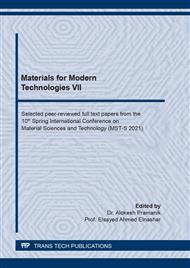[1]
Boothroyd G and Knight W A 1989 Fundamentals of Machining and Machine Tools vol 66 (New York).
Google Scholar
[2]
Singh S, Maheshwari S and Pandey P C 2004 Some investigations into the electric discharge machining of hardened tool steel using different electrode materials J. Mater. Process. Technol. 149 272–7.
DOI: 10.1016/j.jmatprotec.2003.11.046
Google Scholar
[3]
Erden A and Bilgin S 1980 Role of Impurities in Electric Discharge Machining Proc. Twenty-Fourth Int. Mach. Tool Des. Res. Conf. 21 345–50.
Google Scholar
[4]
Jeswani M L 1981 Effect of the addition of graphite powder to kerosene used as the dielectric fluid in electrical discharge machining Wear 70 133–9.
DOI: 10.1016/0043-1648(81)90148-4
Google Scholar
[5]
Kurafuji H and Suda K 1965 Study on Electrical Discharge machining I J. Fac. Eng. Univ. Tokyo(B) XXVIII 1–18.
Google Scholar
[6]
Chow H M, Yang L D, Lin C T and Chen Y F 2008 The use of SiC powder in water as dielectric for micro-slit EDM machining J. Mater. Process. Technol. 195 160–70.
DOI: 10.1016/j.jmatprotec.2007.04.130
Google Scholar
[7]
Ekmekci B and Ersöz Y 2012 How suspended particles affect surface morphology in powder mixed electrical discharge machining (PMEDM) Metall. Mater. Trans. B Process Metall. Mater. Process. Sci. 43 1138–48.
DOI: 10.1007/s11663-012-9700-0
Google Scholar
[8]
Kumar A, Mandal A, Dixit A R and Das A K 2018 Performance evaluation of Al2O3 nano powder mixed dielectric for electric discharge machining of Inconel 825 Mater. Manuf. Process. 33 986–95.
DOI: 10.1080/10426914.2017.1376081
Google Scholar
[9]
Kumar A, Mandal A, Dixit A R, Das A K, Kumar S and Ranjan R 2019 Comparison in the performance of EDM and NPMEDM using Al 2 O 3 nanopowder as an impurity in DI water dielectric Int. J. Adv. Manuf. Technol. 100 1327–39.
DOI: 10.1007/s00170-018-3126-z
Google Scholar
[10]
Marashi H, Jafarlou D M, Sarhan A A D D and Hamdi M 2016 State of the art in powder mixed dielectric for EDM applications Precis. Eng. 46 11–33.
DOI: 10.1016/j.precisioneng.2016.05.010
Google Scholar
[11]
Peças P and Henriques E 2008 Effect of the powder concentration and dielectric flow in the surface morphology in electrical discharge machining with powder-mixed dielectric (PMD-EDM) Int. J. Adv. Manuf. Technol. 37 1120–32.
DOI: 10.1007/s00170-007-1061-5
Google Scholar
[12]
Reddy V V, Kumar A, Valli P M and Reddy C S 2015 Influence of surfactant and graphite powder concentration on electrical discharge machining of PH17-4 stainless steel J. Brazilian Soc. Mech. Sci. Eng. 37 641–55.
DOI: 10.1007/s40430-014-0193-4
Google Scholar


